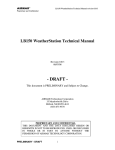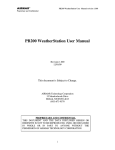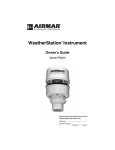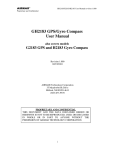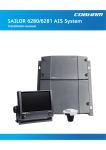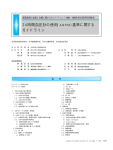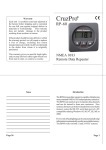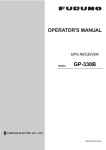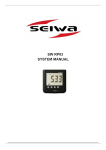Download Airmar PB100 Specifications
Transcript
AIRMAR® PB100 WeatherStation Technical Manual revision 1.007 PB100 WeatherStation Technical Manual also covers model LB100 Revision 1.007 AIRMAR Technology Corporation 35 Meadowbrook Drive Milford, NH 03055-4613 (603) 673-9570 AIRMAR® PB100 WeatherStation Technical Manual revision 1.007 AIRMAR® PB100 WeatherStation Technical Manual revision 1.007 Table of Contents 1. 2. Introduction............................................................................................................. 1 NMEA 0183 Interfaces ........................................................................................... 1 Transmitted NMEA 0183 Sentences .................................................................. 1 $GPGGA............................................................................................................. 4 $GPGLL.............................................................................................................. 6 $GPGSA ............................................................................................................. 7 $GPGSV ............................................................................................................. 8 $HCHDG .......................................................................................................... 10 $WIMDA .......................................................................................................... 11 $WIMWD ......................................................................................................... 13 $WIMWV ......................................................................................................... 14 $GPRMC........................................................................................................... 16 $GPVTG ........................................................................................................... 18 $WIVWR .......................................................................................................... 19 $WIVWT .......................................................................................................... 20 $WIXDR ........................................................................................................... 21 $YXXDR .......................................................................................................... 23 $GPZDA ........................................................................................................... 26 2.2. Received NMEA 0183 Sentences and Commands........................................... 27 2.2.1. Precedence of Data ................................................................................... 29 $--HDG ............................................................................................................. 30 $--RMC ............................................................................................................. 31 $--VHW ............................................................................................................ 32 $--VTG.............................................................................................................. 33 $PAMTC........................................................................................................... 34 $PAMTC,ALT .................................................................................................. 35 $PAMTC,ATTOFF........................................................................................... 37 $PAMTC,BAUD .............................................................................................. 39 $PAMTC,EN .................................................................................................... 40 $PAMTC,ERST ................................................................................................ 45 $PAMTC,OPTION ........................................................................................... 46 $PAMTC,POST ................................................................................................ 49 $PAMTC,QV .................................................................................................... 51 $PAMTC,RESET.............................................................................................. 52 $PAMTX........................................................................................................... 53 2.1. 3. Revision History ................................................................................................... 54 i AIRMAR® PB100 WeatherStation Technical Manual revision 1.007 ii AIRMAR® 1. PB100 WeatherStation Technical Manual revision 1.007 Introduction This document is a supplement to the Airmar PB100 WeatherStation Owner's Guide. This document provides a detailed description of the communications protocol for both transmitted and received NMEA 0183 sentences used by the PB100 WeatherStation. At this writing there are two models of the WeatherStation: the PB100 and the LB100. These are identical, except that the LB100 does not include the integrated GPS, compass, and tilt sensor circuitry. This document covers both models. Some of the transmitted NMEA sentences described in this document are not available on the LB100. For further information about the NMEA 0183 protocol, refer to the document, NMEA 0183 Standard for Interfacing Marine Electronic Devices, v3.01, available from the National Marine Electronics Association (www.nmea.org). 2. NMEA 0183 Interfaces The Airmar WeatherStation has a single standard NMEA 0183-compliant output channel, and a single standard NMEA 0183-compliant input channel. The unit transmits standard NMEA 0183 sentences on its output channel. It also recognizes standard and proprietary NMEA 0183 sentences received on its input channel. The standard baud rate for both input and output channels is 4800 baud, though if desired this may be increased to 38400 baud via a proprietary command.1 The transmitted NMEA 0183 sentences are described in section 2.1. Received NMEA 0183 sentences and proprietary commands are described in section 2.2. 2.1. Transmitted NMEA 0183 Sentences By default, only certain NMEA sentences are enabled for transmission. Other sentences may be enabled individually for transmission via commands sent to the input channel.2 The standard transmission interval for most of the transmitted sentences is once per second. However, in models that include an integrated GPS, if every sentence were enabled for transmission, there would not be enough bandwidth in the output channel at 1 2 See the $PAMTC,BAUD command. See the $PAMTC,EN command. 1 AIRMAR® PB100 WeatherStation Technical Manual revision 1.007 4800 baud to output all sentences within a one second timeframe. Therefore, one or more of the following remedies should be employed: • To conserve bandwidth, only enable for transmission those sentences required for the given application, and disable all others. • Reduce the frequency of transmission for less critical sentences. • Increase the overall bandwidth eightfold by increasing the baud rate from the standard 4800 baud to 38400 baud (though keep in mind that most NMEA 0183 instruments are not capable of operating at 38400 baud) All NMEA sentences transmitted by the WeatherStation include a checksum at the end of the sentence, consisting of an asterisk (*) followed by two ASCII hexadecimal characters. In the detailed specifications to follow, these hexadecimal characters are designated by “hh”. The standard NMEA 0183 sentences provided by the WeatherStation are summarized in Table 1. Each of the transmitted sentences in Table 1 is described in detail on the subsequent pages. The Maximum Length (chars) column in the table indicates an expected worst-case scenario that can be used for bandwidth budgeting. The total time in seconds required to transmit all enabled sentences in a single interval is Total _ transmission _ time = Total _ number _ of _ characters × 10 baud _ rate 2 AIRMAR® PB100 WeatherStation Technical Manual revision 1.007 Table 1: NMEA 0183 Regularly Transmitted Sentences1 Sentence Description PB100 LB100 Enabled by Default Maximum Length (chars) $GPGGA GPS Fix Data 3 No 3 (PB100) 82 $GPGLL Geographic Position – Latitude/Longitude 3 No No 48 $GPGSA GNSS DOP and Active Satellites 3 No No 66 $GPGSV GNSS Satellites in View 3 No No 70 $HCHDG Heading, Deviation and Variation 3 Meteorological Composite. Barometric pressure, air temperature, relative humidity, dew point, wind direction, wind speed 3 No 3 33 $WIMDA No 3 81 $WIMWD Wind Direction and Speed, with respect to north 32 32 3 41 $WIMWV (relative) Wind Speed and Angle, in relation to the vessel’s bow/centerline (relative) 3 3 3 28 $WIMWV (theoretical) Wind Speed and Angle, in relation to the vessel’s bow/centerline (theoretical) 32 32 3 28 $GPRMC Recommended Minimum Specific GNSS Data 3 No No 74 $GPVTG Course Over Ground and Ground Speed 3 No 3 (PB100) 42 $WIVWR Relative Wind Speed and Angle 3 3 No 41 $WIVWT True Wind Speed and Angle 3 3 3 3 41 $WIXDR Transducer Measurements: wind chill and vessel attitude 3 3 No 73 $YXXDR (type A) Transducer Measurements: wind chill, heat index, and station pressure 3 3 No 74 $YXXDR (type B) Transducer Measurements: vessel attitude (pitch and roll) 3 No No 43 $GPZDA Time and Date 3 No 3 (PB100) 38 1 As of firmware version 1.011/1.003. 2 True wind data is provided in the $WIMWD and $WIMWV (theoretical) sentences if SOG/COG, heading, and magnetic variation data are available from an internal or external GPS and compass. 3 $WIVWT True Wind Speed and Angle referenced to water is provided only if water referenced speed is available via the NMEA 0183 input from an Airmar® Smart™ speed sensor. 3 AIRMAR® PB100 WeatherStation Technical Manual revision 1.007 NMEA 0183 TRANSMITTED SENTENCE $GPGGA Summary NMEA 0183 standard GPS Fix Data. Syntax $GPGGA,<1>,<2>,<3>,<4>,<5>,<6>,<7>,<8>, <9>,<10>,<11>,<12>,<13>,<14>*hh<CR><LF> Fields <1> UTC of position, in the form hhmmss <2> Latitude, to the nearest .0001 minute <3> N if field <2> is North Latitude S if field <2> is South Latitude <4> Longitude, to the nearest .0001 minute <5> E if field <4> is East Longitude W if field <4> is West Longitude <6> GPS quality indicator: 0 = Fix not available or invalid 1 = GPS SPS Mode, fix valid 2 = Differential GPS, SPS Mode, fix valid 3 = GPS PPS Mode, fix valid 4 = Real Time Kinematic (RTK) 5 = Float RTK 6 = Estimated (dead reckoning) Mode 7 = Manual Input Mode 8 = Simulator Mode When providing data from the WeatherStation’s internal GPS, the only valid values for the GPS quality indicator are 0 and 1. <7> Number of satellites in use, 0-12 <8> Horizontal dilution of precision (HDOP) <9> Altitude relative to mean-sea-level (geoid), meters (to the nearest whole meter) <10> M <11> Geoidal separation, meters (to the nearest whole meter). This field is not provided by the WeatherStation, and appears as a null field. 4 AIRMAR® PB100 WeatherStation Technical Manual revision 1.007 <12> M. This field is not provided by the WeatherStation, and appears as a null field. <13> Age of Differential GPS data, seconds. This field is not provided by the WeatherStation, and appears as a null field. <14> Differential reference station ID, 0000-1023. This field is not provided by the WeatherStation, and appears as a null field. Default State Enabled. Transmitted once per second. Notes This sentence is not available in the LB100. This sentence may be enabled or disabled via the $PAMTC,EN,GGA command. However, if the WeatherStation receives a VTG or RMC sentence from an external GPS, then this sentence shall not be transmitted. 5 AIRMAR® PB100 WeatherStation Technical Manual revision 1.007 NMEA 0183 TRANSMITTED SENTENCE $GPGLL Summary NMEA 0183 standard Geographic Position – Latitude/Longitude. Syntax $GPGLL,<1>,<2>,<3>,<4>,<5>,<6>,<7>*hh<CR><LF> Fields <1> Latitude, to the nearest .0001 minute <2> N if field <1> is North Latitude S if field <1> is South Latitude <3> Longitude, to the nearest .0001 minute <4> E if field <3> is East Longitude W if field <3> is West Longitude <5> UTC of position, in the form hhmmss <6> Status: A = data valid; V = data invalid <7> Mode indicator: A = Autonomous mode D = Differential mode E = Estimated (dead reckoning) mode M = Manual input mode S = Simulator mode N = Data not valid The only values transmitted by the WeatherStation for the Mode indicator are A and N. Default State Disabled. Once per second when enabled. Notes This sentence is not available in the LB100. This sentence may be enabled via the $PAMTC,EN,GLL command. However, if the WeatherStation receives a VTG or RMC sentence from an external GPS, then this sentence shall not be transmitted. 6 AIRMAR® PB100 WeatherStation Technical Manual revision 1.007 NMEA 0183 TRANSMITTED SENTENCE $GPGSA Summary NMEA 0183 standard GNSS DOP and Active Satellites. Syntax $GPGSA,<1>,<2>,<3>,<4>,<5>,<6>,<7>,<8>,<9>,<10>,<11>, <12>,<13>,<14>,<15>,<16>,<17>*hh<CR><LF> Fields <1> M = Manual, forced to operate in 2D or 3D mode A = Automatic, allowed to automatically switch 2D/3D <2> 1 = Fix not available 2 = 2D fix 3 = 3D fix <3>-<14> ID numbers of satellites used in solution <15> Positional Dilution of Precision (PDOP). This field is null unless the GPS has a 3D fix. <16> Horizontal Dilution of Precision (HDOP). This field is null unless the GPS has either a 2D fix or a 3D fix. <17> Vertical Dilution of Precision (VDOP). This field is null unless the GPS has a 3D fix. Default State Disabled. Once per second when enabled. Notes This sentence is not available in the LB100. This sentence may be enabled via the $PAMTC,EN,GSA command. However, if the WeatherStation receives a VTG or RMC sentence from an external GPS, then this sentence shall not be transmitted. 7 AIRMAR® PB100 WeatherStation Technical Manual revision 1.007 NMEA 0183 TRANSMITTED SENTENCE $GPGSV Summary NMEA 0183 standard GNSS Satellites in View. Syntax $GPGSV,<1>,<2>,<3>,<4>,<5>,<6>,<7>,<8>,<9>,<10>,<11>, <12>,<13>,<14>,<15>,<16>,<17>,<18>,<19>*hh<CR><LF> Fields <1> Total number of GSV sentences (1 to 3 for internal GPS in WeatherStation) <2> Sentence number (1, 2, or 3) <3> Total number of satellites in view <4> Satellite ID number, 1st SV <5> Elevation degrees, 0 to 90, to the nearest degree, 1st SV <6> Azimuth, degrees True, to the nearest degree, 1st SV <7> SNR (C/No) 00-99 dB-Hz, 1st SV (null field if satellite not tracked) <8> Satellite ID number, 2nd SV <9> Elevation degrees, 0 to 90, to the nearest degree, 2nd SV <10> Azimuth, degrees True, to the nearest degree, 2nd SV <11> SNR (C/No) 00-99 dB-Hz, 2nd SV (null field if satellite not tracked) <12> Satellite ID number, 3rd SV <13> Elevation degrees, 0 to 90, to the nearest degree, 3rd SV <14> Azimuth, degrees True, to the nearest degree, 3rd SV <15> SNR (C/No) 00-99 dB-Hz, 3rd SV (null field if satellite not tracked) <16> Satellite ID number, 4th SV <17> Elevation degrees, 0 to 90, to the nearest degree, 4th SV <18> Azimuth, degrees True, to the nearest degree, 4th SV <19> SNR (C/No) 00-99 dB-Hz, 4th SV (null field if satellite not tracked) 8 AIRMAR® PB100 WeatherStation Technical Manual revision 1.007 Default State Disabled. Once per second when enabled. This sentence is transmitted in groups of up to three instances, containing data for up to 4 satellites with each instance, for a total of up to 12 satellites. Fields <1> and <3> only contain data in the first instance; they are null fields in the second and third instances. Notes This sentence is not available in the LB100. This sentence may be enabled via the $PAMTC,EN,GSV command. However, if the WeatherStation receives a VTG or RMC sentence from an external GPS, then this sentence shall not be transmitted. 9 AIRMAR® PB100 WeatherStation Technical Manual revision 1.007 NMEA 0183 TRANSMITTED SENTENCE $HCHDG Summary NMEA 0183 standard Heading, Deviation and Variation. Syntax $HCHDG,<1>,<2>,<3>,<4>,<5>*hh<CR><LF> Fields <1> Magnetic sensor heading, degrees, to the nearest 0.1 degree. <2> Magnetic deviation, degrees east or west, to the nearest 0.1 degree. <3> E if field <2> is degrees East W if field <2> is degrees West <4> Magnetic variation, degrees east or west, to the nearest 0.1 degree. <5> E if field <4> is degrees East W if field <4> is degrees West Default State Disabled. Twice per second when enabled. Notes This sentence is not available in the LB100. This sentence may be enabled or disabled via the $PAMTC,EN,HDG command. However, if the WeatherStation receives heading data in a HDG sentence from an external compass, then this sentence shall not be transmitted. 10 AIRMAR® PB100 WeatherStation Technical Manual revision 1.007 NMEA 0183 TRANSMITTED SENTENCE $WIMDA Summary NMEA 0183 standard Meteorological Composite. Syntax $WIMDA,<1>,<2>,<3>,<4>,<5>,<6>,<7>,<8>,<9>,<10>,<11>, <12>,<13>,<14>,<15>,<16>,<17>,<18>,<19>,<20>*hh <CR><LF> Fields <1> Barometric pressure, inches of mercury, to the nearest 0.01 inch <2> I = inches of mercury <3> Barometric pressure, bars, to the nearest .001 bar <4> B = bars <5> Air temperature, degrees C, to the nearest 0.1 degree C <6> C = degrees C <7> Water temperature, degrees C (this field left blank by WeatherStation) <8> C = degrees C (this field left blank by WeatherStation) <9> Relative humidity, percent, to the nearest 0.1 percent <10> Absolute humidity, percent (this field left blank by WeatherStation) <11> Dew point, degrees C, to the nearest 0.1 degree C <12> C = degrees C <13> Wind direction, degrees True, to the nearest 0.1 degree <14> T = true <15> Wind direction, degrees Magnetic, to the nearest 0.1 degree <16> M = magnetic <17> Wind speed, knots, to the nearest 0.1 knot <18> N = knots <19> Wind speed, meters per second, to the nearest 0.1 m/s <20> M = meters per second Default State Enabled. Transmitted once per second. 11 AIRMAR® PB100 WeatherStation Technical Manual revision 1.007 Notes This sentence may be enabled or disabled via the $PAMTC,EN,MDA command. The barometric pressure provided in this sentence is the altimeter setting, which is the barometric pressure corrected for altitude above sea level. See the transmitted $YXXDR(A) sentence, and the received $PAMTC,ALT command, for further information. 12 AIRMAR® PB100 WeatherStation Technical Manual revision 1.007 NMEA 0183 TRANSMITTED SENTENCE $WIMWD Summary NMEA 0183 standard Wind Direction and Speed, with respect to north. Syntax $WIMWD,<1>,<2>,<3>,<4>,<5>,<6>,<7>,<8>*hh<CR><LF> Fields <1> Wind direction, 0.0 to 359.9 degrees True, to the nearest 0.1 degree <2> T = True <3> Wind direction, 0.0 to 359.9 degrees Magnetic, to the nearest 0.1 degree <4> M = Magnetic <5> Wind speed, knots, to the nearest 0.1 knot. <6> N = Knots <7> Wind speed, meters/second, to the nearest 0.1 m/s. <8> M = Meters/second Default State Enabled. Transmitted once per second. Notes The wind speed and direction data provided in this sentence are calculated using vector math based on the measured apparent wind speed and direction, SOG and COG from a GPS, compass heading, and magnetic variation. If any of these data are not available, this sentence shall be transmitted with null fields. The SOG, COG, and compass heading data used in the calculation may be provided by the internal GPS (if installed), internal compass (if installed), and/or from an external compass and GPS. The decision as to which data will be used is determined by the precedence rules defined in section 2.2.1. This sentence may be enabled or disabled via the $PAMTC,EN,MWD command. 13 AIRMAR® PB100 WeatherStation Technical Manual revision 1.007 NMEA 0183 TRANSMITTED SENTENCE $WIMWV Summary NMEA 0183 standard Wind Speed and Angle, in relation to the vessel’s bow/centerline. Syntax $WIMWV,<1>,<2>,<3>,<4>,<5>*hh<CR><LF> Fields <1> Wind angle, 0.0 to 359.9 degrees, in relation to the vessel’s bow/centerline, to the nearest 0.1 degree. If the data for this field is not valid, the field will be blank. <2> Reference: R = Relative (apparent wind, as felt when standing on the moving ship) T = Theoretical (calculated actual wind, as though the vessel were stationary) <3> Wind speed, to the nearest tenth of a unit. If the data for this field is not valid, the field will be blank. <4> Wind speed units: K = km/hr M = m/s N = knots S = statute miles/hr In the WeatherStation, this field always contains "N" (knots). <5> Status: A = data valid; V = data invalid Default State MWV(R): Enabled. Transmitted twice per second. MWV(T): Enabled. Transmitted once per second. Notes Depending on the contents of the Reference field (field <2>), this sentence provides either relative (apparent) wind or theoretical (true) wind data, both in relation to the bow of the vessel. As it is conceivable that both of these forms could be useful simultaneously, the WeatherStation by default outputs this sentence twice, once in each form. 14 AIRMAR® PB100 WeatherStation Technical Manual revision 1.007 To enable/disable the theoretical (true) form of this sentence, use the $PAMTC,EN,MWVT command. To enable/disable the relative (apparent) form, use the $PAMTC,EN,MWVR command. 15 AIRMAR® PB100 WeatherStation Technical Manual revision 1.007 NMEA 0183 TRANSMITTED SENTENCE $GPRMC Summary NMEA 0183 standard Recommended Minimum Specific GNSS Data. Syntax $GPRMC,<1>,<2>,<3>,<4>,<5>,<6>,<7>,<8>, <9>,<10>,<11>,<12>*hh<CR><LF> Fields <1> UTC of position, in the form hhmmss <2> Status: A = Data Valid; V = Navigation Receiver Warning <3> Latitude, to the nearest .0001 minute <4> N if field <2> is North Latitude S if field <2> is South Latitude <5> Longitude, to the nearest .0001 minute <6> E if field <4> is East Longitude W if field <4> is West Longitude <7> Speed Over Ground, knots, to the nearest 0.1 knot <8> Course Over Ground, degrees True, to the nearest 0.1 degree <9> Date: ddmmyy <10> Magnetic Variation, degrees E/W, to the nearest 0.1 degree <11> E if field <10> is degrees East W if field <10> is degrees West <12> Mode indicator: A = Autonomous mode D = Differential mode E = Estimated (dead reckoning) mode M = Manual input mode S = Simulator mode N = Data not valid The only values transmitted by the WeatherStation for the Mode indicator are A and N. Default State Disabled. Once per second when enabled. 16 AIRMAR® PB100 WeatherStation Technical Manual revision 1.007 Notes This sentence is not available in the LB100. This sentence may be enabled or disabled via the $PAMTC,EN,RMC command. However, if the WeatherStation receives a VTG or RMC sentence from an external GPS, then this sentence shall not be transmitted. 17 AIRMAR® PB100 WeatherStation Technical Manual revision 1.007 NMEA 0183 TRANSMITTED SENTENCE $GPVTG Summary NMEA 0183 standard Course Over Ground and Ground Speed. Syntax $GPVTG,<1>,<2>,<3>,<4>,<5>,<6>,<7>,<8>,<9>*hh<CR><LF> Fields <1> Course Over Ground, degrees True, to the nearest 0.1 degree <2> T = True <3> Course Over Ground, degrees Magnetic, to the nearest 0.1 degree <4> M = Magnetic <5> Speed Over Ground, knots, to the nearest 0.1 knot <6> N = Knots <7> Speed Over Ground, km/hr, to the nearest 0.1 km/hr <8> K = km/hr <9> Mode indicator: A = Autonomous mode D = Differential mode E = Estimated (dead reckoning) mode M = Manual input mode S = Simulator mode N = Data not valid The only values transmitted by the WeatherStation for the Mode indicator are A and N. Default State Enabled. Transmitted once per second. Notes This sentence is not available in the LB100. This sentence may be enabled or disabled via the $PAMTC,EN,VTG command. However, if the WeatherStation receives a VTG or RMC sentence from an external GPS, then this sentence shall not be transmitted. 18 AIRMAR® PB100 WeatherStation Technical Manual revision 1.007 NMEA 0183 TRANSMITTED SENTENCE $WIVWR Summary NMEA 0183 Relative (Apparent) Wind Speed and Angle. Wind angle in relation to the vessel’s heading, and wind speed measured relative to the moving vessel. Syntax $WIVWR,<1>,<2>,<3>,<4>,<5>,<6>,<7>,<8>*hh<CR><LF> Fields <1> Measured wind angle relative to the vessel, 0 to 180°, left/right of vessel heading, to the nearest 0.1 degree <2> L = left, or R = right <3> Measured wind speed, knots, to the nearest 0.1 knot <4> N = knots <5> Wind speed, meters per second, to the nearest 0.1 m/s <6> M = meters per second <7> Wind speed, km/h, to the nearest km/h <8> K = km/h Default State Disabled. Transmitted once per second if enabled. Notes This sentence may be enabled or disabled via the $PAMTC,EN,VWR command. 19 AIRMAR® PB100 WeatherStation Technical Manual revision 1.007 NMEA 0183 TRANSMITTED SENTENCE $WIVWT Summary NMEA 0183 True wind angle in relation to the vessel’s heading, and true wind speed referenced to the water. True wind is the vector sum of the Relative (apparent) wind vector and the vessel’s velocity vector relative to the water along the heading line of the vessel. It represents the wind at the vessel if it were stationary relative to the water and heading in the same direction. Syntax $WIVWT,<1>,<2>,<3>,<4>,<5>,<6>,<7>,<8>*hh<CR><LF> Fields <1> Calculated wind angle relative to the vessel, 0 to 180°, left/right of vessel heading, to the nearest 0.1 degree <2> L = left, or R = right <3> Calculated wind speed, knots, to the nearest 0.1 knot <4> N = knots <5> Wind speed, meters per second, to the nearest 0.1 m/s <6> M = meters per second <7> Wind speed, km/h, to the nearest km/h <8> K = km/h Default State Disabled, but automatically enabled if water speed is provided via the NMEA 0183 input. Transmitted once per second when enabled. Notes This sentence can be manually enabled or disabled via the $PAMTC,EN,VWT command. 20 AIRMAR® PB100 WeatherStation Technical Manual revision 1.007 NMEA 0183 TRANSMITTED SENTENCE $WIXDR Summary NMEA 0183 Transducer Measurements. Used in the WeatherStation to provide wind chill data, and vessel attitude (pitch and roll) data. Syntax $WIXDR,<1>, <2>, <3>, <4>, <5>, <6>, <7>, <8>, <9>, <10>,<11>,<12>, <13>,<14>,<15>,<16> *hh<CR><LF> Fields <1> C = temperature <2> Calculated “relative” wind chill temperature, degrees Celsius, to the nearest 0.1 degree <3> C = degrees C <4> WCHR (ID indicating relative wind chill) <5> C = temperature <6> Calculated “theoretical” wind chill temperature, degrees Celsius, to the nearest 0.1 degree <7> C = degrees C <8> WCHT (ID indicating theoretical wind chill) <9> A = angular displacement <10> Pitch: oscillation of vessel about its latitudinal axis. Bow moving up is positive. Value reported to the nearest 0.1 degree. <11> D = degrees <12> PTCH (ID indicating pitch of vessel) <13> A = angular displacement <14> Roll: oscillation of vessel about its longitudinal axis. Roll to the starboard is positive. Value reported to the nearest 0.1 degree. <15> D = degrees <16> ROLL (ID indicating roll of vessel) 21 AIRMAR® PB100 WeatherStation Technical Manual revision 1.007 Default State Disabled. Transmitted once per second when enabled. Notes The $WIXDR sentence is provided for backward compatibility. It is recommended to use the newer $YXXDR(A) and $YXXDR(B) sentences, instead, which provide more information. The fields in the $WIXDR sentence are grouped in sets of four. There may be up to four sets, with four fields per set, in a single transmitted $WIXDR sentence. Each set contains, in order, the four fields <Type>, <Data>, <Units>, and <ID>. If for some reason the contents of a given set are not available, then the entire set (including commas) may be omitted. It is necessary when parsing any XDR sentence to examine the <ID> field in each set of four fields in order to identify the meaning of the data in that set. The $WIXDR sentence may be enabled via the $PAMTC,EN,XDR command. The wind chill temperature is the perceived temperature on a person’s face at the current wind speed. The calculation assumes that the wind speed measured by the sensor is the same as the wind speed at the face of an observer. The “relative” wind chill uses the measured apparent wind speed for this calculation, and the “theoretical” wind chill uses the calculated true wind speed. The reported pitch and roll values are adjusted by the azimuth, pitch, and roll offsets established with the $PAMTC,ATTOFF command. At this writing, the pitch and roll features are only provided in PB100 units with hardware version 3. Model LB100 does not provide pitch and roll. The $PAMTC,QV query can be used to determine the hardware version for a given unit. See also the $YXXDR(A) and $YXXDR(B) sentences, on the next page. 22 AIRMAR® PB100 WeatherStation Technical Manual revision 1.007 NMEA 0183 TRANSMITTED SENTENCE $YXXDR Summary NMEA 0183 Transducer Measurements. Used in the PB100 WeatherStation to provide wind chill, heat index, barometric station pressure, and vessel attitude (pitch and roll) data. IMPORTANT NOTE: See the discussion in the Notes section below regarding the behavior of the XDR sentence with regard to null fields and commas. Syntax $YXXDR,<1>, <2>, <3>, <4>, <5>, <6>, <7>, <8>, <9>, <10>,<11>,<12>, <13>,<14>,<15>,<16> *hh<CR><LF> Fields There are two versions of this sentence, the "A" version, and the "B" version. The fields in the A version of the XDR sentence are as follows: <1> C = temperature <2> Calculated “relative” wind chill temperature, degrees Celsius, to the nearest 0.1 degree <3> C = degrees C <4> WCHR (ID indicating relative wind chill) <5> C = temperature <6> Calculated “theoretical” wind chill temperature, degrees Celsius, to the nearest 0.1 degree <7> C = degrees C <8> WCHT (ID indicating theoretical wind chill) <9> C = temperature <10> Calculated heat index, degrees Celsius, to the nearest 0.1 degree <11> C = degrees C <12> HINX (ID indicating heat index) <13> P = pressure 23 AIRMAR® PB100 WeatherStation Technical Manual revision 1.007 <14> Actual measured barometric pressure, or "station pressure", bars, to the nearest 0.001 bar <15> B = bars <16> STNP (ID indicating station pressure) The fields in the B version of the XDR sentence are as follows: <1> A = angular displacement <2> Pitch: oscillation of vessel about its latitudinal axis. Bow moving up is positive. Value reported to the nearest 0.1 degree. <3> D = degrees <4> PTCH (ID indicating pitch of vessel) <5> A = angular displacement <6> Roll: oscillation of vessel about its longitudinal axis. Roll to the starboard is positive. Value reported to the nearest 0.1 degree. <7> D = degrees <8> ROLL (ID indicating roll of vessel) <9> Not used <10> Not used <11> Not used <12> Not used <13> Not used <14> Not used <15> Not used <16> Not used Default State $YXXDR(A): Disabled. Transmitted once per second when enabled. $YXXDR(B): Disabled. Transmitted twice per second when enabled. Notes The fields in an XDR sentence are grouped in sets of four. There may be up to four sets, with four fields per set, in a single transmitted XDR sentence. Each set contains, in order, the four fields <Type>, <Data>, <Units>, and <ID>. If for some reason the contents of a given set are not available, then the entire set (including commas) may be omitted. 24 AIRMAR® PB100 WeatherStation Technical Manual revision 1.007 Because there are two versions of the XDR sentence, and because a group of four fields can be omitted entirely, it is necessary when parsing any XDR sentence to examine the <ID> field in each set of four fields in order to identify the meaning of the data in that set. The XDR(A) sentence may be enabled via the $PAMTC,EN,XDRA command. The XDR(B) sentence may be enabled via the $PAMTC,EN,XDRB command. The wind chill temperature is the perceived temperature on a person’s face at the current wind speed. The calculation assumes that the wind speed measured by the sensor is the same as the wind speed at the face of an observer. The “relative” wind chill uses the measured apparent wind speed for this calculation, and the “theoretical” wind chill uses the calculated true wind speed. The wind chill temperature is only defined when the air temperature is below 50°F (10°C) and the wind speed is above 3 mph. The heat index is the apparent temperature felt by a person's skin when exposed to air with a high moisture content. Dry air allows evaporative cooling of the skin's surface. The higher the humidity, the less the skin can cool itself with evaporative cooling. The heat index is only defined when air temperature is above 80°F (27°C) and relative humidity is above 40%. The barometric station pressure is the raw, uncorrected barometric pressure reading. This is provided here in the XDRA sentence, and is distinct from the altimeter setting, which is the barometric pressure corrected for altitude, provided in the MDA sentence. The reported pitch and roll values are adjusted by the azimuth, pitch, and roll offsets established with the $PAMTC,ATTOFF command. The B version of the XDR sentence is not available in the model LB100. 25 AIRMAR® PB100 WeatherStation Technical Manual revision 1.007 NMEA 0183 TRANSMITTED SENTENCE $GPZDA Summary NMEA 0183 standard Time and Date Syntax $GPZDA,<1>,<2>,<3>,<4>,<5>,<6>*hh<CR><LF> Fields <1> UTC of position, in the form hhmmss <2> Day, 01 to 31 <3> Month, 01 to 12 <4> Year, four digits (e.g. 2006) <5> Local zone hours, always set to 00 in PB100 <6> Local zone minutes, always set to 00 in PB100 Default State Enabled. Transmitted once per second. Notes This sentence is not available in the LB100. This sentence may be enabled or disabled via the $PAMTC,EN,ZDA command. However, if the WeatherStation receives a VTG or RMC sentence from an external GPS, then this sentence shall not be transmitted. 26 AIRMAR® 2.2. PB100 WeatherStation Technical Manual revision 1.007 Received NMEA 0183 Sentences and Commands The WeatherStation has an NMEA 0183-compliant input channel that is capable of receiving standard NMEA sentences as well as proprietary commands for initialization, calibration, or to modify the behavior of the unit. All received sentences and commands can include or omit the NMEA checksum. If a checksum is included, the sentence will be checked against its checksum, and the sentence will be accepted only if there is a checksum match. If the NMEA checksum is excluded, it is required that the preceding asterisk (*) also be excluded. If no checksum is provided, the WeatherStation will accept the sentence without error checking. It is recommended that all sentences and commands provided to the WeatherStation include a checksum to help ensure integrity of the transmitted data. The sentences recognized by the WeatherStation on the serial input channel are summarized in Table 2 on the next page. Note that the prefix “$--” appearing in the descriptions for several of the listed sentences should be replaced by a “$” followed by the two-character talker ID of the transmitting device. Each of the sentences in Table 2 is described in detail on the subsequent pages. 27 AIRMAR® PB100 WeatherStation Technical Manual revision 1.007 Table 2: NMEA 0183 Received Sentences and Commands Sentence or Command Description $--HDG Standard NMEA Heading, Deviation, and Variation $--RMC Standard NMEA Recommended Minimum Specific GNSS Data (for magnetic variation, SOG, COG) $--VHW Standard NMEA Water Speed and Heading (for water speed) $--VTG Standard NMEA COG and SOG $PAMTC,ALT Program the PB100 WeatherStation with altitude settings $PAMTC,ATTOFF Program the WeatherStation with angular attitude offsets: azimuth, pitch, and roll $PAMTC,BAUD Change the baud rate from the nominal 4800 baud to 38400 baud $PAMTC,EN Enable/disable transmission of specific sentences, and change their rate of transmission $PAMTC,ERST Reset the user portion of nonvolatile EEPROM to factory defaults $PAMTC,OPTION Enable/disable certain WeatherStation features $PAMTC,QV Query WeatherStation hardware and firmware versions $PAMTC,RESET Reset the WeatherStation $PAMTX Pause or resume all automatic transmission of messages 28 AIRMAR® PB100 WeatherStation Technical Manual revision 1.007 2.2.1. Precedence of Data In a given installation, certain data items might be available from more than one source. In this circumstance, the following precedence rules apply. The calculation of true wind, in particular, depends on these precedence rules. SOG/COG: $--VTG supersedes $--RMC, which supersedes the WeatherStation's internal GPS. Note that to be valid, SOG and COG must both be available from the same source. Magnetic Variation: $--HDG supersedes $--VTG, which supersedes $--RMC, which supersedes the WeatherStation internal calculation. The internal calculation determines magnetic variation using the present position and the date: these data provided from an external GPS will supersede the data from the internal GPS. Heading and Deviation: $--HDG supersedes the internal compass. (Note: if heading is supplied in a received $--VHW sentence, it is ignored.) 29 AIRMAR® PB100 WeatherStation Technical Manual revision 1.007 _NMEA 0183 RECEIVED SENTENCE_ $--HDG Summary NMEA 0183 standard Heading, Deviation and Variation. Syntax $--HDG,<1>,<2>,<3>,<4>,<5>*hh<CR><LF> Fields <1> Magnetic sensor heading, degrees. <2> Magnetic deviation, degrees east or west. <3> E if field <2> is degrees East W if field <2> is degrees West <4> Magnetic variation, degrees east or west. <5> E if field <4> is degrees East W if field <4> is degrees West Notes See section 2.2.1. for precedence rules regarding data received via this sentence. 30 AIRMAR® PB100 WeatherStation Technical Manual revision 1.007 _NMEA 0183 RECEIVED SENTENCE_ $--RMC Summary NMEA 0183 standard Recommended Minimum Specific GNSS Data. Syntax $--RMC,<1>,<2>,<3>,<4>,<5>,<6>,<7>,<8>, <9>,<10>,<11>,<12>*hh<CR><LF> Fields <1> UTC of position <2> Status: A = Data Valid; V = Navigation Receiver Warning <3> Latitude <4> N if field <2> is North Latitude S if field <2> is South Latitude <5> Longitude <6> E if field <4> is East Longitude W if field <4> is West Longitude <7> Speed Over Ground, knots <8> Course Over Ground, degrees True <9> Date: ddmmyy <10> Magnetic Variation, degrees E/W <11> E if field <10> is degrees East W if field <10> is degrees West <12> Mode indicator: A = Autonomous mode D = Differential mode E = Estimated (dead reckoning) mode M = Manual input mode S = Simulator mode N = Data not valid Notes See section 2.2.1. for precedence rules regarding data received via this sentence. 31 AIRMAR® PB100 WeatherStation Technical Manual revision 1.007 _NMEA 0183 RECEIVED SENTENCE_ $--VHW Summary NMEA 0183 standard Water Speed and Heading. Syntax $--VHW,<1>,<2>,<3>,<4>,<5>,<6>,<7>,<8>*hh<CR><LF> Fields <1> Compass Heading, degrees True <2> T = true <3> Compass Heading, degrees Magnetic <4> M = magnetic <5> Water speed, knots <6> N = knots <7> Water speed, km/h <8> K = km/h Notes This sentence is used to obtain water speed from an Airmar® Smart™ speed sensor. The water speed data is used to calculate true wind relative to the water. The compass heading fields in this sentence are ignored by the WeatherStation. 32 AIRMAR® PB100 WeatherStation Technical Manual revision 1.007 _NMEA 0183 RECEIVED SENTENCE_ $--VTG Summary NMEA 0183 standard Course Over Ground and Ground Speed. Syntax $--VTG,<1>,<2>,<3>,<4>,<5>,<6>,<7>,<8>,<9>*hh<CR><LF> Fields <1> Course Over Ground, degrees True <2> T = True <3> Course Over Ground, degrees Magnetic <4> M = Magnetic <5> Speed Over Ground, knots <6> N = Knots <7> Speed Over Ground, km/hr <8> K = km/hr <9> Mode indicator: A = Autonomous mode D = Differential mode E = Estimated (dead reckoning) mode M = Manual input mode S = Simulator mode N = Data not valid Notes See section 2.2.1. for precedence rules regarding data received via this sentence. 33 AIRMAR® PB100 WeatherStation Technical Manual revision 1.007 _NMEA 0183 RECEIVED SENTENCE_ $PAMTC Summary Prefix for recognized proprietary commands. Syntax $PAMTC,<1>…*hh<CR><LF> Fields <1> Command mnemonic. This may be any of the following: ALT ATTOFF BAUD EN ERST OPTION QV RESET The number and meaning of any subsequent fields is dependent on the command mnemonic. Each of the command mnemonics defines a separate proprietary command (or set of commands) recognized by the WeatherStation. These commands are each described in their own section on the following pages. 34 AIRMAR® PB100 WeatherStation Technical Manual revision 1.007 _NMEA 0183 RECEIVED SENTENCE_ $PAMTC,ALT Summary Settings related to the altitude of the PB100. Syntax One of the following forms: $PAMTC,ALT,SET,<2>,<3>,<4>*hh<CR><LF> $PAMTC,ALT,Q*hh<CR><LF> Fields <2> Fixed altitude, -999.99 meters to +40,000.00 meters, to the nearest 0.01 meter. Default value = 0 meters <3> 0 = Do not use fixed altitude for GPS 2D mode 1 = Use fixed altitude for GPS 2D mode Default value = 1 <4> 0 = Do not use altitude for barometric pressure altimeter setting ($WIMDA, fields 1 and 3) 1 = Barometric pressure altimeter setting uses fixed altitude (field <2>). 2 = Barometric pressure altimeter setting uses GPS altitude when GPS has a 3D fix, or fixed altitude (field <2>) when GPS does not have a 3D fix. Default value = 2. Notes The $PAMTC,ALT,SET,<2>,<3>,<4> command is used to program the PB100 WeatherStation with a fixed altitude setting to be used in calculating a more accurate GPS position when the GPS is operating in 2D mode, and in calculating the barometric pressure altimeter setting provided in fields 1 and 3 of the transmitted $WIMDA sentence. 35 AIRMAR® PB100 WeatherStation Technical Manual revision 1.007 Fields <3> and<4> of the $PAMTC,ALT,SET command define how to use the altitude setting provided in field <2>. All of the parameters of the $PAMTC,ALT,SET command are stored in nonvolatile EEPROM memory within the PB100, and so remain programmed even after cycling power. If any of the fields <2>, <3>, or <4> are null fields, the corresponding stored value will remain unchanged. The $PAMTC,ALT,Q command is used to query the values of the parameters currently programmed into the PB100. The unit will reply with $PAMTR,ALT,a,b,c where a, b, and c correspond to fields <2>, <3>, and <4>, respectively, in the $PAMTC,ALT,SET command. See also: NMEA 0183 received proprietary sentence $PAMTC,OPTION, option 2. NMEA 0183 transmitted sentence $WIMDA (barometric pressure altimeter setting) NMEA 0183 transmitted sentence $YXXDR (barometric pressure station pressure). 36 AIRMAR® PB100 WeatherStation Technical Manual revision 1.007 _NMEA 0183 RECEIVED SENTENCE_ $PAMTC,ATTOFF Summary A set of proprietary commands to set and query the angular attitude offsets for the WeatherStation. Syntax One of the following forms: $PAMTC,ATTOFF,SET,<3>,<4>,<5>*hh<CR><LF> $PAMTC,ATTOFF,Q*hh<CR><LF> Fields <3> Signed azimuth offset (yaw, or bow offset), degrees, to the nearest tenth of a degree. The value must be between -180.0 and +180.0 degrees. Negative values indicate the forward mark on the sensor housing is oriented toward the starboard side of the vessel; positive values toward the port side. <4> Signed pitch offset, degrees, to the nearest tenth of a degree. The value must be between -45.0 and +45.0 degrees. Positive values indicate the sensor is tilted forward toward the bow; negative values indicate the sensor is tilted aftward. <5> Signed roll offset, degrees, to the nearest tenth of a degree. The value must be between -45.0 and +45.0 degrees. Positive values indicate the sensor is tilted toward the port side; negative values toward the starboard side. Notes The $PAMTC,ATTOFF,SET,<3>,<4>,<5> command is used to program the WeatherStation with the attitude offset angles when the sensor is not oriented parallel to the centerline, and perpendicular to the deck of the vessel. The programmed values are stored in nonvolatile EEPROM memory within the WeatherStation, and so remain programmed even after cycling power. If any of the fields <3>, <4>, or <5> are null fields, the corresponding stored value will remain unchanged. The $PAMTC,ATTOFF,Q command is used to query the values of the attitude offset angles currently programmed into the WeatherStation. The unit will reply with $PAMTR,ATTOFF,a,b,c 37 AIRMAR® PB100 WeatherStation Technical Manual revision 1.007 where a is the current signed azimuth offset value, b is the current signed pitch offset value, and c is the current signed roll offset value. All values are reported to the nearest tenth of a degree. The factory default value for all three parameters is 0.0 degrees. The azimuth offset angle is used to adjust the apparent wind angle relative to the bow of the vessel, and the vessel’s heading when using the internal compass. These values are further used in calculating the true wind speed and angle. The azimuth offset angle, along with the pitch and roll offset angles are also used to adjust the reported pitch and roll values in the transmitted $WIXDR sentence. A properly set azimuth offset angle will allow the unit to accurately report pitch and roll of the vessel, even though the orientation mark on the sensor housing may not be facing precisely toward the bow. The recommended procedure to set these offsets is as follows: 1. If the unit is mounted on a vessel, this procedure should be performed with calm water and no wind, and with the vessel at rest. 2. First, zero out all offsets by sending the command $PAMTC,ATTOFF,SET,0,0,0. 3. Determine the desired azimuth offset angle, and program this into the sensor using the command $PAMTC,ATTOFF,SET,a where a is the azimuth offset of the sensor relative to the bow, in degrees. The pitch and roll offset fields should be omitted for this step (or set to zeroes). 4. Allow the vessel to stabilize to its "level" state, and then read the values of pitch and roll that are reported by the XDR sentence. If the vessel is rocking back and forth, then take a number of readings and calculate an average for both pitch and roll. 5. Program the negated versions of these measured pitch and roll values back into the unit with the $PAMTC,ATTOFF,SET,,b,c sentence. For example, if the XDR sentence reports an average pitch angle of 6.2 degrees, and an average roll angle of -4.3 degrees, then you would send the sentence $PAMTC,ATTOFF,SET,,-6.2,4.3 to the WeatherStation. Note that the azimuth offset field in this sentence is a null field, indicating we are not changing its value at this time. 6. At this point the transmitted XDR sentences should be producing values that are centered around 0.0 degrees for both pitch and roll. 7. The programmed attitude offset values may be checked at any time by sending the command $PAMTC,ATTOFF,Q to the unit; it will reply with $PAMTR,ATTOFF,a,b,c. 38 AIRMAR® PB100 WeatherStation Technical Manual revision 1.007 _NMEA 0183 RECEIVED SENTENCE_ $PAMTC,BAUD Summary Change the baud rate for both the transmitting and receiving NMEA 0183 channels. Syntax One of the following forms: $PAMTC,BAUD,4800*hh<CR><LF> $PAMTC,BAUD,38400*hh<CR><LF> Notes The $PAMTC,BAUD command may be used to increase the baud rate from the standard 4800 baud to 38400 baud. This will provide an eightfold increase in the bandwidth of the NMEA 0183 interface, allowing more data to be transmitted in a given period of time. On power up, the NMEA input and output interfaces always default to 4800 baud. It is recommended to employ the following sequence when changing the baud rate for the WeatherStation from 4800 baud to 38400 baud. The following assumes there is a single host device communicating with the WeatherStation: 1. Send the $PAMTX command to the WeatherStation (at 4800 baud) to temporarily disable transmission of periodic sentences. 2. Send the $PAMTC,BAUD,38400 command (at 4800 baud) to instruct the WeatherStation to change its baud rate to 38400. The unit will finish transmitting any periodic sentences in progress at 4800 baud, and will then change its interface to use 38400 baud. 3. Delay a short interval within the host to allow reception of any remaining queued sentences from the WeatherStation at 4800 baud. 4. Change the baud rate on the host's serial port to 38400 baud. 5. Send the $PAMTX,1 command to the WeatherStation (at 38400 baud) to resume transmission of periodic sentences. 6. All subsequent communication with the WeatherStation will be at 38400 baud, until the unit is powered down or reset, or the $PAMTC,BAUD,4800 command is sent to the unit. Note that a baud rate of 38400 does not comply with the NMEA 0183 standard. 39 AIRMAR® PB100 WeatherStation Technical Manual revision 1.007 _NMEA 0183 RECEIVED SENTENCE_ $PAMTC,EN Summary Enable or disable the periodic transmission of individual standard NMEA 0183 sentences, and specify their rate of transmission. Syntax One of the following forms: $PAMTC,EN,<2>,<3>,<4>*hh<CR><LF> $PAMTC,EN,S*hh<CR><LF> $PAMTC,EN,L*hh<CR><LF> $PAMTC,EN,LD*hh<CR><LF> $PAMTC,EN,Q*hh<CR><LF> Fields <2> The identifier ALL, or one of the following sentence ID’s: Model PB100: GGA, GLL, GSA, GSV, HDG, MDA, MWD, MWVR, MWVT, RMC, VTG, VWR, VWT, XDR, XDRA, XDRB, ZDA Model LB100: MDA, MWD, MWVR, MWVT, VWR, VWT, XDR, XDRA <3> If field <2> is the ALL identifier, then 0 = disable transmission of all sentences 1 = enable transmission of all sentences. Otherwise, 0 = disable transmission of the specified sentence 1 = enable transmission of the specified sentence <4> The amount of time between successive transmissions of the specified sentence, in tenths of a second. For example, if field <4> contains the value 5, this specifies an interval of 0.5 seconds between successive transmissions of the specified sentence. If field <2> is the ALL identifier, then field <4> specifies the transmission interval for all sentences. 40 AIRMAR® PB100 WeatherStation Technical Manual revision 1.007 Notes The factory default settings are as follows: Sentence ID Enabled by default? GGA 31 GLL – GSA – GSV – HDG – 3 MDA 3 MWD 3 MWV (R) 3 MWV (T) RMC – VTG 31 VWR – 3 VWT XDR – XDRA – XDRB – ZDA 31 1 Default Transmission Interval 10 10 10 10 5 10 10 5 10 10 10 10 10 10 10 5 10 PB100 only Note that the MWV sentence appears in two forms: relative (R) and theoretical (T). These two forms are enabled separately. Also note that the XDR sentence appears in three forms: $WIXDR, $YXXDR(A), and $YXXDR(B). These three forms are enabled separately. If either of fields <3> or <4> is a null field, then that field will remain unchanged from its previous value. The selections as to which sentences are enabled for transmission, and the rate at which each sentence is transmitted, are stored in nonvolatile EEPROM memory within the WeatherStation unit. On power up, these settings are copied from EEPROM into a working copy in RAM memory. It is the working copy in RAM that determines the behavior of the WeatherStation, with regard to the transmission of sentences. Any changes to these settings using the $PAMTC,EN,<2>,<3>,<4> command only affect the working copy in RAM. When power is lost, the changes to the working copy in RAM will be lost. 41 AIRMAR® PB100 WeatherStation Technical Manual revision 1.007 The $PAMTC,EN,S command causes the contents of the current working copy in RAM to be saved to EEPROM. The saved settings will then be restored to RAM each time power is applied to the unit. The $PAMTC,EN,L command allows the settings to be reloaded from EEPROM to RAM without cycling power to the unit. This can be used to discard any changes made to the working copy in RAM, and restore the saved settings as though the unit had been turned off and then back on again. The $PAMTC,EN,LD command loads the factory default settings from ROM memory into RAM memory. Note that the $PAMTC,ERST command (see separate description) differs from the $PAMTC,EN,LD command in that $PAMTC,ERST will initialize all of user EEPROM memory to its factory default settings. This includes settings unrelated to the selection of transmitted sentences. The above paragraphs are summarized in the below figure. Working Copy (RAM) TC N, ,E LD Saved Copy (EEPROM) AM $P S N, L ,E C N, ,E MT C A T $P AM $P $PAMTC,ERST Factory Defaults (ROM) The $PAMTC,EN,Q command provides a query function to allow reading the current settings from the working copy in RAM. The reply to the $PAMTC,EN,Q command is a series of sentences with the following format: $PAMTR,EN,<1>,<2>,<3>,<4>,<5>*hh<CR><LF> where <1> = Total number of $PAMTR,EN sentences in the reply <2> = Sentence number <3> = Sentence ID (GGA, GLL, GSA, GSV, HDG, MDA, MWD, MWVR, MWVT, RMC, VTG, VWR, VWT, or XDR) <4> = 0 or 1 (0=disabled, 1=enabled) 42 AIRMAR® PB100 WeatherStation Technical Manual revision 1.007 <5> = Transmission interval (tenths of a second) For example, a unit programmed with only the factory default settings would provide the following as a reply to the $PAMTC,EN,Q command: $PAMTR,EN,17,1,GGA,1,10*17 $PAMTR,EN,17,2,GLL,0,10*13 $PAMTR,EN,17,3,GSA,0,10*00 $PAMTR,EN,17,4,GSV,0,10*10 $PAMTR,EN,17,5,HDG,0,5*2C $PAMTR,EN,17,6,MDA,1,10*19 $PAMTR,EN,17,7,MWD,1,10*0E $PAMTR,EN,17,8,MWVR,1,5*75 $PAMTR,EN,17,9,MWVT,1,10*46 $PAMTR,EN,17,10,RMC,0,10*3B $PAMTR,EN,17,11,VTG,1,10*22 $PAMTR,EN,17,12,VWR,0,10*36 $PAMTR,EN,17,13,VWT,1,10*30 $PAMTR,EN,17,14,XDR,0,10*2D $PAMTR,EN,17,15,XDRA,0,10*6D $PAMTR,EN,17,16,XDRB,0,5*59 $PAMTR,EN,17,17,ZDA,1,10*3E Keep in mind when enabling sentences that the overall bandwidth of the interface should not be exceeded. At 4800 baud, only 480 characters can be transmitted in a one second period of time. If every one of the above sentences were enabled for transmission, their total number of characters could exceed 800. It is possible to use the $PAMTC,EN command to overspecify the amount of data transmitted, beyond the bandwidth capacity of the NMEA output channel. See section 2.1. for further information regarding bus bandwidth. Examples Example 1: To disable all sentences for transmission, except transmit compass heading 5 times per second, and save the settings in EEPROM, send the following sequence of commands to the unit: $PAMTC,EN,ALL,0 $PAMTC,EN,HDG,1,2 $PAMTC,EN,S Example 2: To reload the factory defaults for the $PAMTC,EN settings into EEPROM without affecting other EEPROM settings (such as attitude offsets set with the 43 AIRMAR® PB100 WeatherStation Technical Manual revision 1.007 $PAMTC,ATTOFF command), send the following sequence of commands to the unit: $PAMTC,EN,LD $PAMTC,EN,S Example 3: To enable transmission of the XDR sentence and set it to transmit at the slow rate of once every 10 seconds for the current session only, send the following command to the unit: $PAMTC,EN,XDR,1,100 Example 4: To disable transmission of the MWV(T) sentence permanently: $PAMTC,EN,MWVT,0 $PAMTC,EN,S Example 5: To enable transmission of all of the GPS-related sentences, and disable all others, for the current session only: $PAMTC,EN,ALL,0 $PAMTC,EN,GGA,1 $PAMTC,EN,GLL,1 $PAMTC,EN,GSA,1 $PAMTC,EN,GSV,1 $PAMTC,EN,RMC,1 $PAMTC,EN,VTG,1 $PAMTC,EN,ZDA,1 44 AIRMAR® PB100 WeatherStation Technical Manual revision 1.007 _NMEA 0183 RECEIVED SENTENCE_ $PAMTC,ERST Summary Reset the user portion of nonvolatile EEPROM to its factory default state. Syntax $PAMTC,ERST*hh<CR><LF> Notes The following data items are saved in nonvolatile EEPROM within the WeatherStation. For each item, the default value, and the command used to change the value is shown. Item Default value Changed via command Azimuth offset 0.0° $PAMTC,ATTOFF Pitch offset 0.0° $PAMTC,ATTOFF Roll offset 0.0° $PAMTC,ATTOFF List of sentences enabled for transmission See the description for the $PAMTC,EN command $PAMTC,EN Rates of transmission of sentences See the description for the $PAMTC,EN command $PAMTC,EN Disabled $PAMTC,OPTION GPS fix 2D, 3D, or Auto Auto $PAMTC,OPTION Altitude settings 0,1,2 $PAMTC,ALT Allow COG to be used instead of internal compass heading in true wind calculations Other items related to factory calibration of the sensor are also saved in EEPROM, but these items are not affected by the $PAMTC,ERST command. 45 AIRMAR® PB100 WeatherStation Technical Manual revision 1.007 _NMEA 0183 RECEIVED SENTENCE_ $PAMTC,OPTION Summary Enable or disable certain WeatherStation features, or query their state. Syntax One of the following forms: $PAMTC,OPTION,SET,<3>,<4>*hh<CR><LF> $PAMTC,OPTION,Q,<3>*hh<CR><LF> Fields Option 1: <3> 1 = Allow COG to be used instead of internal compass heading in true wind calculations <4> 1 = Feature enabled 0 = Feature disabled (default) Option 2: <3> 2 = Set GPS fix mode <4> 1 = 2D fix only 2 = 3D fix only 3 = Automatic selection of 2D or 3D mode (default) Notes Option 1: If the local magnetic inclination (dip) is severe, this can produce errors in the compass heading when the vessel is not level. Since the compass heading is used in the calculations for true wind, this can also result in errors in the reported true wind speed and direction. (Apparent wind is not affected.) The WeatherStation can be instructed to use Course Over Ground (COG) provided by the internal GPS in place of the internal compass heading in the calculations for true wind. The command to enable this feature is $PAMTC,OPTION,SET,1,1. If this feature is enabled, then the COG will be used instead of internal compass heading for calculation of true wind only if the GPS 46 AIRMAR® PB100 WeatherStation Technical Manual revision 1.007 has achieved a fix, and if the Speed Over Ground (SOG) is greater than 3 knots. If there is no GPS fix, or if the SOG is 3 knots or less, then the internal compass heading will be used. Do be aware when using this feature that Heading and COG are not the same. Heading refers to the direction the bow of the vessel is pointing. COG refers to the direction the vessel is traveling. While in an automobile these values are likely to be nearly identical, in a boat they can differ because of the effects of wind and current on the vessel. The rationale for using COG instead of heading in the calculations for true wind is that the difference between COG and actual heading might be less than the error in the reported compass heading due to dip. The setting is saved in nonvolatile EEPROM within the WeatherStation. To disable this feature, use the command $PAMTC,OPTION,SET,1,0. When disabled, the COG will not be used in place of internal compass heading under any circumstances. The WeatherStation may be queried to determine the state of this feature. If the command $PAMTC,OPTION,Q,1 is received, the unit will transmit the reply $PAMTR,OPTION,1,0 if the feature is disabled, or $PAMTR,OPTION,1,1 if enabled. Option 2: The GPS receiver in the PB100 can calculate a position fix when it has achieved a lock on at least three GPS satellites. If it has achieved a lock on four or more satellites, the unit may be able to calculate a 3D position fix, meaning it can determine latitude, longitude, and altitude. But if it has achieved a lock on only three satellites, it may only be able to calculate a 2D position fix, meaning it can determine latitude and longitude, but not altitude. By default, the unit will automatically calculate a 3D position fix if it is able to, but will fall back to 2D position fixing if there are not enough satellites being tracked. It is possible to restrict the operation of the GPS to only allow 3D position fixes by sending the unit the command $PAMTC,OPTION,SET,2,2. If this is done, then the unit will not calculate a position fix until it has achieved a lock on at least four satellites. Note that sometimes the GPS may be tracking at least four satellites, but is still unable to calculate a position fix. This is because the positions of the satellites in the sky must be satisfactory in order to achieve good geometry in the fix calculation, as determined by the HDOP, VDOP, and PDOP values. 47 AIRMAR® PB100 WeatherStation Technical Manual revision 1.007 It is also possible to restrict the operation of the GPS to only allow 2D position fixes by sending the unit the command $PAMTC,OPTION,SET,2,1. To re-enable the automatic selection of 2D versus 3D fix calculations, send the unit the command $PAMTC,OPTION,SET,2,3. This setting is stored in EEPROM within the unit, and retrieved on power up. The current setting may be queried by issuing the $PAMTC,OPTION,Q,2 command. The unit will respond with the sentence $PAMTR,OPTION,Q,2,<4>, where the value of <4> is 1, 2, or 3, corresponding to 2D, 3D, or Automatic mode, respectively. When calculating a 2D position fix, the latitude/longitude values may have a relatively large error if the altitude of the GPS receiver is not set appropriately. This can be corrected by programming a fixed altitude offset into the unit. See the $PAMTC,ALT command on page 35. Note that sometimes the GPS may be tracking at least four satellites, but is still unable to calculate a position fix. This is because the positions of the satellites in the sky must be satisfactory in order to achieve good geometry in the fix calculation, as determined by the HDOP, VDOP, and PDOP values. 48 AIRMAR® PB100 WeatherStation Technical Manual revision 1.007 _NMEA 0183 RECEIVED SENTENCE_ $PAMTC,POST Summary Perform the Power-On Self Test. Syntax $PAMTC,POST*hh<CR><LF> The WeatherStation will reply with a sentence in the following form: $PAMTR,POST,<1>,<2>,<3>,<4>,<5>,<6>,<7>,<8>, <9>,<10>,<11>*hh<CR><LF> Each of the fields <1> through <11> contains an integer value that represents the status of a simple test performed on a given submodule within the WeatherStation. For each field, a value of 0 (zero) indicates the unit passed the respective test; a nonzero value indicates a possible problem was discovered with the given submodule. Therefore, a properly operating unit would reply with $PAMTR,POST,0,0,0,0,0,0,0,0,0,0,0. The fields and their corresponding submodules are listed below. where <1> = Internal communication between microprocessors <2> = Factory EEPROM <3> = User EEPROM <4> = Air temperature sensor <5> = Plate temperature sensor <6> = Relative humidity sensor <7> = Barometric pressure sensor <8> = Wind sensor <9> = Compass sensor <10> = GPS receiver <11> = Attitude sensor Notes The various tests performed for the POST function are simple tests to determine if the hardware is minimally responding to software stimuli. The POST function should not be regarded as a comprehensive indicator that a given unit is healthy. In other words, it is possible that a defective unit might still pass the POST operation. However, the POST can be useful to identify certain types of problems with the WeatherStation. 49 AIRMAR® PB100 WeatherStation Technical Manual revision 1.007 Certain models of the WeatherStation may omit some features in the hardware. For example, model LB100 omits the internal GPS receiver, compass sensor, and attitude sensor. In this case, the corresponding fields in the POST sentence will be null (blank) fields. The Power-On Self Test is performed automatically a few seconds after applying power to the unit. 50 AIRMAR® PB100 WeatherStation Technical Manual revision 1.007 _NMEA 0183 RECEIVED SENTENCE_ $PAMTC,QV Summary Query version information. Syntax $PAMTC,QV*hh<CR><LF> The WeatherStation will reply with a sentence in the following form: $PAMTR,QV,<1>,<2>,<3>,<4>,<5>,<6>,<7>,<8>,<9>*hh<CR><LF> where <1> <2> <3> <4> <5> <6> <7> <8> <9> = = = = = = = = = Part number Hardware version OEM option Serial number of unit Bootloader 1 firmware version Application 1 firmware version Bootloader 2 firmware version Application 2 firmware version GPS module version 51 AIRMAR® PB100 WeatherStation Technical Manual revision 1.007 _NMEA 0183 RECEIVED SENTENCE_ $PAMTC,RESET Summary Reset the WeatherStation. Syntax $PAMTC,RESET*hh<CR><LF> The WeatherStation will reset as though power had been removed and reapplied. All settings will revert to their power-on defaults. 52 AIRMAR® PB100 WeatherStation Technical Manual revision 1.007 _NMEA 0183 RECEIVED SENTENCE_ $PAMTX Summary Suspend and resume transmission of NMEA sentences. Syntax $PAMTX,<1>*hh<CR><LF> Fields <1> 0 = temporarily suspend transmission of all NMEA sentences. (default) 1 = resume transmission Notes Upon receiving this sentence, the WeatherStation will suspend transmission of all future NMEA sentences after the currently transmitting sentence has completed. If the $PAMTX command is received with no fields present (i.e. $PAMTX*50<CR><LF> or $PAMTX<CR><LF>, the default case shall prevail, i.e. transmission of sentences will be suspended. Transmission of NMEA sentences will resume when one of the following has occurred: • A $PAMTX,1 command has been received. • The power to the WeatherStation has been cycled. • A $PAMTC,RESET command has been received. 53 AIRMAR® 3. PB100 WeatherStation Technical Manual revision 1.007 Revision History Revision 1.000 Date: Description: 12/14/05 Initial release. Revision 1.001 Date: Description: 1/17/06 Added pitch and roll, and POST sections. Revision 1.002 Date: Description: Revision 1.003 Date: Description: Revision 1.004 Date: Description: Revision 1.005 Date: Description: Revision 1.006 Date: Description: Revision 1.007 Date: Description: 2/22/06 Expanded $PAMTC,EN description, and explanation of XDR sentences. This revision corresponds to the release of firmware version 1.005/1.001. 6/1/06 Added details specific to model LB100, and new $PAMTC,OPTION command. This revision corresponds to the release of firmware version 1.006/1.002. 12/1/06 Modified default enabled sentences to now enable GGA and VTG, and disable RMC. This revision corresponds to the release of firmware version 1.007/1.002. 12/12/06 Added transmitted ZDA sentence. Updated description of $PAMTC,EN. This revision corresponds to the release of firmware version 1.011/1.003. 2/15/07 Added transmitted $YXXDR sentences. Added received $PAMCT,ALT command. Added received $PAMTC,OPTION,,2 command. Removed $PAMTC,LAMP. Updated descriptions of $PAMTC,EN and $WIMDA. This revision corresponds to the release of firmware version 1.015/1.005. 3/22/07 Added station pressure fields to transmitted $YXXDR(A) sentence, which was inadvertently omitted from previous revision. 54


























































